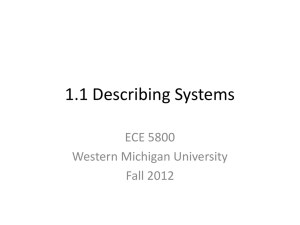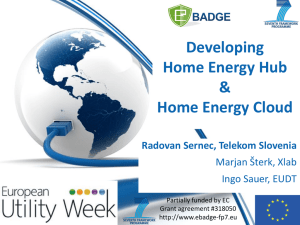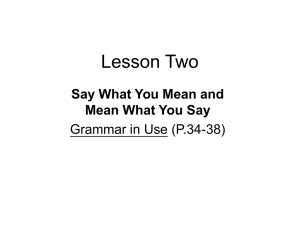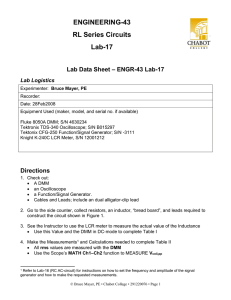RL Series Circuits ENGINEERING-43 Lab-14 – ENGR-43 Lab-14
advertisement
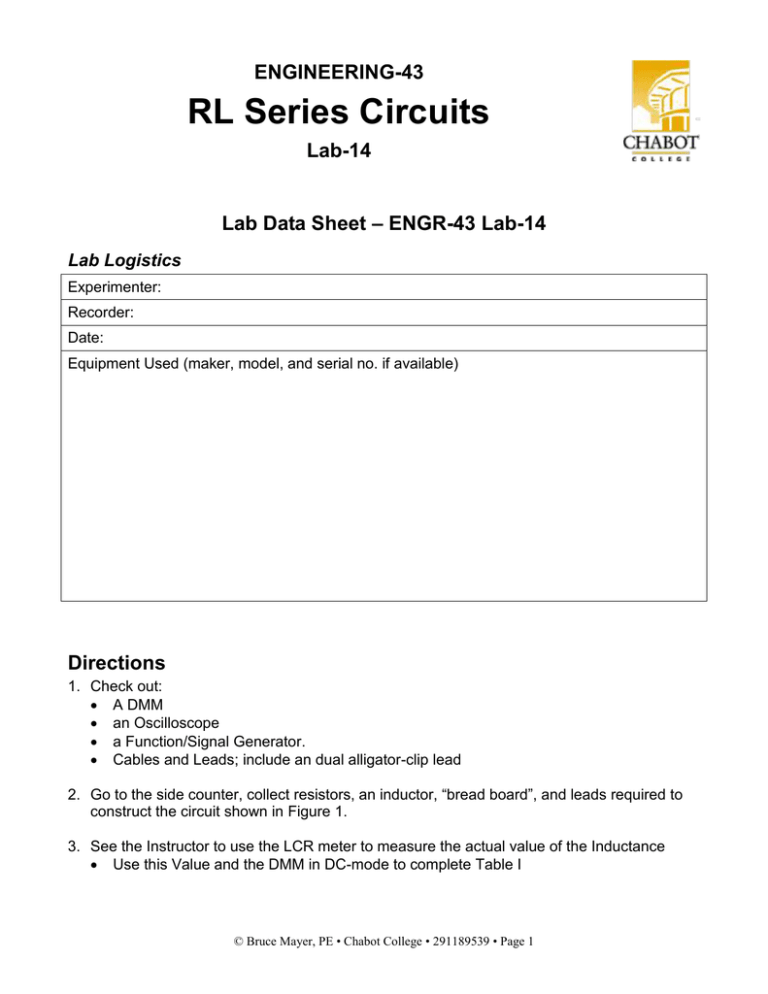
ENGINEERING-43 RL Series Circuits Lab-14 Lab Data Sheet – ENGR-43 Lab-14 Lab Logistics Experimenter: Recorder: Date: Equipment Used (maker, model, and serial no. if available) Directions 1. Check out: A DMM an Oscilloscope a Function/Signal Generator. Cables and Leads; include an dual alligator-clip lead 2. Go to the side counter, collect resistors, an inductor, “bread board”, and leads required to construct the circuit shown in Figure 1. 3. See the Instructor to use the LCR meter to measure the actual value of the Inductance Use this Value and the DMM in DC-mode to complete Table I © Bruce Mayer, PE • Chabot College • 291189539 • Page 1 4. Make the Measurements1 and Calculations needed to complete Table II All rms values are measured with the DMM Use the Scope’s MATH Ch1–Ch2 function to MEASURE Vcoil,pp Use the scope MEASURE function to set the frequency and amplitude for the SignalGenerator for the listed frequencies. Use the Scope to Measure the Resistor, R2, Phase-Difference, , in Terms of TIME using the scope CURSOR function as was described in Lab-16 5. Perform the Calculations needed to complete Table III Use the Signal Period and the Inductor Phase Time-Difference, , to calculate the inductor phase ANGLE, , in degrees (°) Using measured values rms values calculate: |Zcoil|= Vcoil,rms/Irms Recall that Zcoil = Rw + jωL Now use the pythagorean formula to calculate L from |Zcoil|: Zcoil Rw2 2 L2calc 2 Use the calculation and the LCR meter data to determine the % for the Inductor as L-% = 100x(LLCR – Lcalc)/LLCR 6. Use the Previous measurements and Calculations needed to complete Table IV The Impedance should be stated in POLAR Form, 7. Make the Measurements and Calculations needed to complete Table V All Voltage values Should be PHASORS, stated in polar form Determine The Phasor Value of Vcoil algebraically as the voltage-drop difference: Vcoil,calc1 = Vs – VR2,meas Determine The Phasor Value of Vcoil algebraically as the voltage-divider ratio: Vcoil,calc2 = Vs(Zcoil/Ztotal) o Calculate this value of Zcoil using LLCR: Zcoil = Rw + jωLLCR o Calculate Ztotal as: R2,DMM + Zcoil and Zcoil = Rw + jωLLCR Calculate VR2 using Voltage-Divider methods, utilizing the previously measured or calculated values of the impedances VR2 = Vs(R2/Ztotal) o Use the Ztotal value from just above 8. Make the Measurements and Calculations needed to complete Table VII Calculate the two Result Rations as RRc = (Vcoil,calc2)/(Vcoil,calc1) RRR2 = (VR2,calc)/(VR2,meas) 9. Make the Measurements and Calculations needed to complete Table VIII Measurements for Vcoil , Vs, VR2 and are made with the OscilloScope 1 Refer to Lab-16 (RC AC-circuit) for instructions on how to set the frequency and amplitude of the signal generator and how to make the requested measurements. © Bruce Mayer, PE • Chabot College • 291189539 • Page 2 Measure Vs using CH1 Measure VR2 using CH2 Use the Scope’s MATH Ch1–Ch2 function functions to measure Vcoil as: o Vcoil = Vs – VR2 Be sure to note whether is LEADING or LAGGING Calculate the Resistor Phase Angle using the standard method based on ratio of :T || = (360°)(/T) = Sign of based on LEAD or LAG o LEAD → Positive o LAG → Negative The Resistor Phase Angle, , MUST stated in degrees (°) 10. Return all lab hardware to the “as-found” condition Figure 1 • RL Series Circuit. Vs = 13 Vpp (Vamplitude = 6.5V), Vs = 6.5V0º, f per the data-tables, L = 100 mH (nominally), R2 = 1.7-2.3 kΩ (2 kΩ nominally) © Bruce Mayer, PE • Chabot College • 291189539 • Page 3 Table I – Measure L using the LCR-Meter, and measure Rw and R2 with the DMM in the DC mode Digital-Meter Actual-Values R2 = Rw L= Table II – Inductance Measurements Use the Scope’s MATH Ch1–Ch2 function to MEASURE Vcoil,pp Frequency, f T VR2,pp VS,rms for VR2 Vcoil,pp Vcoil,rms Icoil,rms VR2,rms 1000 Hz 3333 Hz 10000 Hz Table III – Inductance Calculations Frequency, f for VR2 |Zcoil| 1000 Hz 3333 Hz 10000 Hz © Bruce Mayer, PE • Chabot College • 291189539 • Page 4 Lcalc L-% Table IV – Series RL Impedance Calculation Frequency, f Lcalc Rw Zcoil R2 Ztotal 1000 Hz 3333 Hz 10000 Hz Table V – Series RL Potential Measurements and Calculations For Vs, VR2,meas, and Vcoil simply state in PHASOR form the measurements taken for Table VI Frequency, f Vs VR2,meas Vcoil,calc1 Vcoil,calc2 1000 Hz 3333 Hz 10000 Hz Table VII – Series RL Potential Calculation Result Ratio State RR in POLAR for with proper units to at least 3 significant figures Frequency, f RRc = (Vcoil,calc2)/(Vcoil,calc1) RRR2 = (VR2,calc)/(VR2,meas) 1000 Hz 3333 Hz 10000 Hz © Bruce Mayer, PE • Chabot College • 291189539 • Page 5 VR2,calc Table VIII – Series RL Potential Measurements Sweep Use the Scope’s MATH Ch1–Ch2 function to MEASURE Vcoil,pp Frequency, f Vs,pp T VR2,pp Vcoil,pp 100 Hz 13V0º 400 Hz 13V0º 1250 Hz 13V0º 2.5 kHz 13V0º 8.0 kHz 13V0º 25.0 kHz 13V0º 80 kHz 13V0º for VR2 for VR2 NOTE: in Table VIII CALCULATE for VR2 using the measured value of for VR2 11. Use MATLAB or EXCEL to create two SemiLog plots of the data contained in Plot the Data Table VIII. In both plots the frequency, f, will be plotted on the Logarithmic scale Plot-1 Independent variable = log(f) TWO dependent variables on the same plot: Vcoil,pp and VR2,pp Plot-2 Independent variable = log(f) Dependent variable = Attach both plots to this lab report ANALYZE the trends shown in the plots, and comment on the physical CAUSE of the observed trends HINT: Consider the Behavior of the Circuit in these extreme cases o →0 o →∞ © Bruce Mayer, PE • Chabot College • 291189539 • Page 6 Run Notes/Comments Print Date/Time = 29-May-16/03:59 © Bruce Mayer, PE • Chabot College • 291189539 • Page 7

